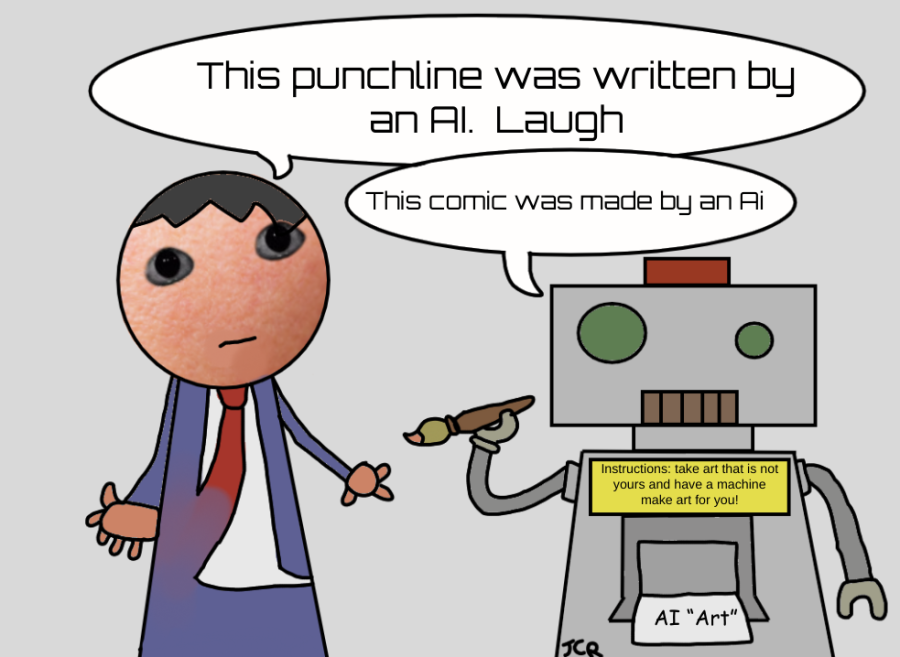AI Draws Attention Away From Artists
J
Editorial Cartoon depicting current levels of accuracy of AI art when it comes to human like figures and the way AI produces art. Comic by JC Ramirez Delgadillo
March 6, 2023
As Artificial Intelligence (AI) becomes a part of everyday life, it is taking over jobs for those working in retail, transportation, and translation. However, when it comes to creative projects, such as writing and art, there should be a limit on what AI can intervene with.
AI is the simulation of human intelligence which is processed by computer systems. It works by combining a large variety of data, alongside an algorithm which allows the software to develop and learn patterns automatically. The rise of AI tools such as ChatGPT, a software that can produce extended text from a single sample, can lead to issues of plagiarism in academic environments. Also, AI art software like DALL-E 2 and Midjourney, software that produces images based on a prompt, have caused controversy with artists whether or not AI art is considered a true art form. Art can be defined as the expression of human creativity through skill and imagination – the removal of the human aspect of art would leave art pieces to be empty shells of machine generated work attempting to mimic human emotion.
ChatGPT is an AI program developed by Open AI that operates in a conversational format. A user can write a sample of text, and the program is able to expand that idea into more elaborate forms of writing such as emails, questions, and essays. AI has had a large impact in education with the addition of a new form of plagiarism, but AI is also affecting other areas such as art and creation due to the rise of AI art. AI art, similar to writing generated by AI, works by being fed pieces of art to train the program to develop pieces through text input. According to the Artland Magazine, the algorithm works by finding patterns in different pieces of art and associating keywords with specific characteristics or art styles. Some artists argue that AI art is not true art, and it can have a major impact on the roles artists play for society. It is important to realize that working as a freelance artist, income is not stable, unlike a full time job. Developing AI that can produce art pieces decreases job opportunities for artists and can negatively affect their income.
An argument that was made for the introduction of AI is that it is similar to the introduction of photography. According to the New York Times, the 19th-century French poet and art critic Charles Baudelaire, called photography “art’s most mortal enemy.” While it is an advancement, photography has over the years become its own separate form of art. Contrasting AI art with traditional digital art is like comparing apples to oranges: they are both art but made in very different ways. Unfortunately AI art is made by other pieces of art, often stolen.
Many artists such as Polish artist Greg Rutkowski make the claim that AI programs steal from them directly and indirectly. In order for AI programs to work, people need to insert different works in order for the program to start learning, creating the issue of art being stolen from people and used to make more pieces in the style of the artist. Independent artists feel the detriment of this because this decreases the chances of commissions or exposure, as was the case with Rutkowski. He is known for his classical art style which he uses to make fantasy themed landscapes. His distinctive art style has gained popularity as an AI prompt, so much so that his art is not the first thing that shows up on the internet. Independent artists feel the detriment of this because this decreases the chances of commissions, with art becoming more accessible people feel it’s easier to just take other people’s work and place it into a machine. There is a huge difference between taking time drawing, shading and producing traditional digital artwork and writing a text prompt to give to a robot.
Accuracy is one of the flaws of AI art. Programs, like DALL-E 2, are given hundreds of images to work with but will struggle with hands, faces and other human features. DALL-E 2 would have a harder time producing a portrait of a person than a logo.
There are many issues with AI generated content, from its potential to encourage academic dishonesty to art theft. AI has started to replace jobs that can be done without humans, but there are occupations that require creativity and human emotion to be successful— two things that AI will never have.



